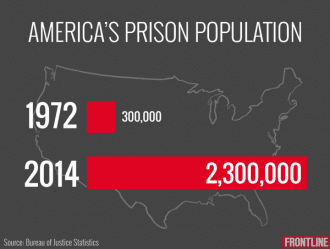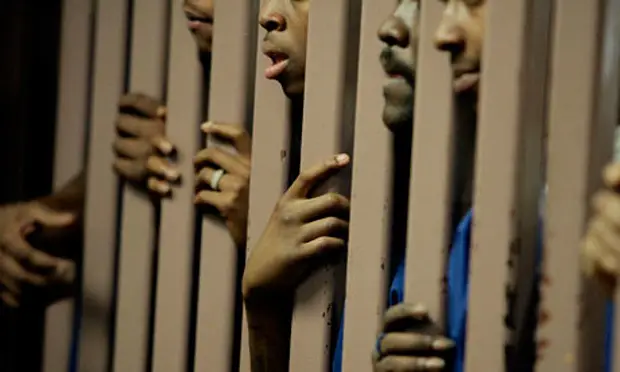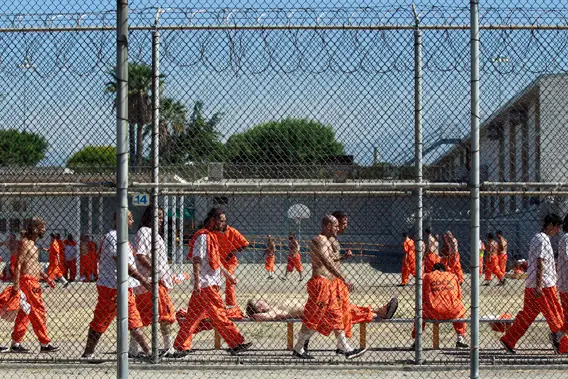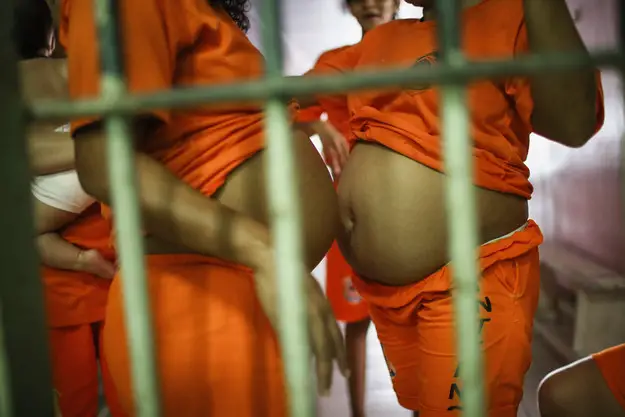By Cortland Pfeffer with Irwin Ozborne
Guest writers for Wake Up World
“Prisoner number [XX]… It is time to go home.” The most beautiful words she had ever heard. She had dreamt about the day that phrase would be uttered for the past ten years. Today, she will get to see her daughter that has been out of her life and begin the process of reunification.
As she takes her first steps outside the prison walls in a decade, it is like stepping into a foreign land. Outside the concrete confinement she is overwhelmed by the simplicity of feeling the fresh breeze, the sunlight, the green grass, and of course her family. Her daughter, mother, and brother await her release in what feels like another world away. Her lower lip starts to tremble uncontrollably – which it always has done when she becomes emotional – only to see her 13-year-old daughter’s lower lip mirror that of her own. Mother-and-daughter are able to embrace for the first time in years as they share an electric bond that cannot be broken, despite so many unanswered questions over the years.
“Why is Mom in jail? Why didn’t I get to have a Mom while growing up? Why wasn’t anyone there to do the things that everyone else enjoyed with their Mom? Where was my Mom all this time?”
These are the questions the little girl repeatedly asked throughout her lifetime without an answer that ever seemed to make sense. She once even wrote a letter to the judge, prior to her mother’s sentencing. It was written in 6 year old writing, in a blue crayon. It said: “Please help my mommy, I don’t want her to go to jail for a long time. I want her to get better.”
[pro_ad_display_adzone id=”110028″]
This woman was a prisoner of war — the War On Drugs. Another unnecessary and ineffective war that has destroyed far more lives than it has helped. A war that has built the highest population of incarcerated people per capita in the history of civilization — and yet the enemy (drug use) is at an all-time high.
The War on Drugs is the longest active war in American history and continues to run with no end in sight because it benefits the rich at the expense of the poor. Society’s most vulnerable people are literally being reduced to a number, while corporations, politicians, and congressmen that write the laws of the land are profiting from the lives they are helping to tear apart.
The Great Prison Marketing Scheme:
On June 17, 1971, President Richard Nixon officially declared the War on Drugs:
“America’s public enemy number one in the United States is drug abuse. In order to fight and defeat this enemy, it is necessary to wage a new, all-out offensive.”
A war is defined as a conflict between different nations or states or different groups within a nation or state. But, to declare a war on an inanimate object or concept means that there is no clear enemy – hence, no end.
And this is intentional. In fact, it is one of the greatest marketing schemes never told. It is drawn out as follows:
1) The President tells you the greatest risk to our safety is a concept, object, or philosophy (Communism, Drugs, Terror, etc.).
- Declares a war that is not really a war (Cold War, Drug War, War on Terror).
- The American people are asked to pay the bill because money is not an issue – this is for our safety and security.
- They create a special agency that makes their own laws in their war (CIA, DEA, NSA, Homeland Security, etc.)
2) Laws are changed that support fighting this war – leading to mass incarcerations of anyone not in compliance.
3) The prisons become over-crowded, and therefore, private prisons run by corporations need to be built to house prisoners.
- Corporations are for-profit, which means more prisoners equals more money
- They sign contracts with the government guaranteeing high occupancy rates (usually between 90-100 percent for up to twenty years).
- This gives incentives to lock up more people, because they have to pay regardless as to whether or not the bed is filled
- The quality of care and supervision is poor, because it is a business and they seek cheap labor and cost-cutting techniques like every business
- Corporations then rent prisoners for free labor- also known as slavery
4) The private prisons then lobby Congress to make stricter laws that enable more people to be locked up.
5) Congress obliges because it helps them win elections and:
- Congress makes the laws of the country – and they don’t bite the hand that feeds
- Then, since they know the laws, they buy stock in these same private prisons
- Profit off their investments
6) Then the war against a concept shifts overseas.
- This allows our government to overthrow poor countries under the disguise as a war against our greatest threat.
- Allowing to steal natural resources
- Install a puppet government that benefits our corporate interests
- Politicians that declare war also have stock in Arms manufacturers like General Electric, Raytheon, etc.
- More wars means more arms need to be built
- They profit off their investments again
- In order to overthrow governments without making it obvious to the public, they hire guerilla insurgents to do so.
- They train these rebel groups and supply arms
- In turn, these groups pay for the arms by supplying illegal drugs
7) The CIA returns these illegal drugs into the inner cities of America.
8) They then arrest people and put them into private prisons (from which they profit), by selling the same drugs they brought into the country (from which they profit) to arm rebel groups to overthrow governments and install puppet governments which support U.S. Corporations and gain further profit (in which the law-makers also have stock interests).

This approach to increasing the prison population has been incredibly successful, with more than a 700% increase in incarceration rates since 1972. It is such a brilliant concept that we have recently followed suit by launching a War on Terror — another war without a clear enemy, against a concept, which will never have a definitive outcome, and which only profits those with heavy stock interests (i.e. John Kerry, US Secretary of State, has made $26 million off his investments directly related to the War on Terror; but that is not a conflict of interest??)
This is not freedom, this is fascism.
The US proudly claims to be “Land of the Free” yet it has more people locked up than any other civilization in the history of the world, with the majority of them in there for non-violent drug offenses. The United States is home to only 5% of the world’s population, but holds almost a quarter of the world’s prison population, while the total correctional population nears 7 million (including people on parole, probation and juvenile detention, but not including detained refugees and military prisoners).
War on Drugs Race
All the drug laws in America have their racist and discriminatory foundations. The first drug-law came in 1875 in San Francisco, which was a banning of Opium Dens as a discrimination against Chinese-American immigrants. National headlines linked cocaine to causing violent behavior in African-Americans and laws were soon put in place. Marijuana was first used recreationally in the Southwestern United States by Mexican immigrants 1920’s, and laws were established that was geared at incriminating Mexicans.
But these were just the early battles before war was officially declared. Today, approximately 12% of the US population is African-American, but they make up 60% of the nation’s male inmates (source: U.S. Department of Justice). There are also more African-American men incarcerated in the U.S. than the total prison populations in India, Argentina, Canada, Lebanon, Japan, Germany, Finland, Israel and England combined, while the US currently has more black men and women behind bars per capita than in the Apartheid-era South Africa. Furthermore, a 2012 registry of exonerated criminals showed that African-Americans make up 50% of all innocent people imprisoned in the US.
In June of 1971, Nixon declared the War on Drugs making most street drugs illegal with stricter penalties. Two years later, the DEA was created to enforce drug laws and bring those “criminals” to justice.
More arrests, meant more people in jails and prisons. The prisons started to overflow and they need for more prisons arose. Corporations got involved and built private, for-profit prisons. They arrange contracts with the government to remain at high occupancy’s, further incentives for the government to arrest non-violent drug offenders and keep them for longer sentences.
[pro_ad_display_adzone id=”110030″]
In the notorious, “Kids for Cash Scandal” two judges in Pennsylvania were convicted of taking cash payments from private prisons as bribery to sentence more juveniles to fill their beds. They were locking up kids for minor offenses — such as mocking a school principal on Myspace, or trespassing in a vacant building — changing innocent lives forever, all for sums of money. And these are just the judges that got caught.
The prison industry spends millions of dollars each year lobbying with the US Congress to change and retain laws that allow locking up more and more people for non-violent drug offenses. In turn, many members of Congress – the people who write the laws – have investments in private prisons, encouraging them to keep these laws that help their stock portfolios.
Prison Labor
An increased prison population helps out more than just the prison industry, many other corporations have invested in prison labor. At least 37 states have legalized contracting of US prison labor – a workforce of over 2 million, or around 1 in every 110 Americans – including corporations such as IBM, Motorola, Microsoft, AT&T, Dell, Honeywell, Target, and many more mount their operations inside of prisons.
This is also known as slavery.
In fact, this idea of convict leasing arose after the Civil War. The South was built by stealing Native American land and utilizing free slave labor to build America into one of the wealthiest nations on Earth. But after slavery was abolished and African-Americans were emancipated, the corporations needed cheap labor. Freed slaves started getting charged with petty crimes and sentenced to many years in prison. Once in prison, they were leased to work, picking cotton and building railroads – just slavery with a different name.
Since the Drug War launched in 1971, the prison population has skyrocketed, locking up Americans and, in particular, African-Americans at an alarming rate, to work for free for corporations. As a society, we really have not changed, we have just found new and creative ways to hide our human rights crimes better.
Just Say KNOW
In 1986, Nancy Regan told us to “Just Say No” to drugs. While she was telling us not to do drugs, her husband and president, Ronald Reagan, was making illegal deals to fund illegal wars which brought those same drugs into our inner cities.
The Iran-Contra scandal involved Reagan illegally selling arms to Iran (despite an embargo on arms to Iran) in exchange for payments. This money went to fund the Nicaraguan contra rebel fighters to embark in a guerilla war against the Sandinista government of Nicaragua. The Sandinista government was democratically-elected (which I thought we liked, right?) which overtook a forty-year-old Somoza dictatorship (which is something we don’t like, right?)
The Sandinista government implemented welfare, health, education, and housing reforms. Peasants were granted access to land to help socio-economic growth. Citizens were given freedom of speech, assembly, council and religion.
They also looked to nationalize many U.S. Corporations and give resources back to their people, most notably, the United Fruit Company, a subsidiary of the W.R. Grace Company – a major supporter of the Reagan administration. Since this would cost corporations and investors money, they deemed that the Nicaraguan government were communists and that we needed to protect Nicaragua from this “evil” regime.
The CIA went to extreme efforts, including getting involved in the illegal drug trade of cocaine from the Contras. They shipped crack-cocaine into the major cities as payments for fighting the guerilla war against the Nicaraguan government. The drugs hit the streets and crack was in all the major cities in the 1980s. The media told us the dangers of crack and people agreed a problem had to be “solved” by locking up anyone who uses it.
The Anti-Drug Act of 1986, told us because crack is so much more powerful than powder cocaine that the sentencing must also be more severe. The laws stated that if you had 100-times less crack than powder cocaine, you received similar sentences. For example, if you possessed five grams of crack you faced a mandatory of five-years in prison (you would need five-hundred grams of powdered cocaine for the same sentence).
Former LAPD narcotics officer Mike Ruppert addressed the corruption of the CIA with then-CIA director, John Deutsch, in a 1996 town hall meeting by stating the following:
“I will tell you Director Deutch, as a former Los Angeles Police narcotics Detective, that the Agency has dealt drugs throughout this country for a long time.”
This was followed by an uproar and applause from the local residents in attendance, which had to be literally silenced before he was allowed to continue.
“Director Deutch, I will refer you to three specific Agency operations known as Amadeus, Pegasus and Watchtower. I have Watchtower documents, heavily redacted by the Agency. I was personally exposed to CIA operations and recruited by CIA personnel who attempted to recruit me in the late seventies to become involved in protecting Agency drug operations in this country. I have been trying to get this out for eighteen years, and I have the evidence. My question for you is very specific sir. If, in the course of the IG’s investigation, you come across evidence of severely criminal activity, and it’s classified, will you use that classification to hide the criminal activity, or will you tell the American people the truth?”
After another large applause and interruption, CIA Director John Deutsch responded by saying:
“If you have information about CIA illegal activity – in drugs – you should immediately bring that information to wherever you want, but let me suggest three places – the Los Angeles Police Department [interrupted by laughter from the residents], the Inspector General, or the office of one of your congresspersons…”
After Congressman Julian Dixon addressed the situation, Ruppert responded with one final blow:
“I did bring this information out eighteen years ago and I got shot at and forced out of LAPD because of it. I’ve been on the record eighteen years non-stop, and I’ll be happy to give you congressmen anything that I have.”
Former LA Police Officer Mike Ruppert Confronts CIA Director John Deutch on Drug Trafficking
Myth: “Bad Guys” Go To Jail
The statistics will tell you about 75% of women in jail have been abused. That number is wrong; the number is closer to 100%. I have worked in jails and in this system for over 18 years now, I have read thousands of charts. Not one of them has a case in which the patient/inmate was not the victim of some sort of trauma.
Studies have lower numbers because the patient/inmate may not report past trauma. That does not mean that it did not occur – either it has been repressed or they do not wish to share due to shame, guilt, or embarrassment. The Hippocampus shuts down during trauma, helping us to forget the actual event. The effects on the brain linger, the neurochemistry of the event has affected us for a lifetime, exposing us to the much higher likelihood of addiction.
Harry Harlow conducted a series of experiments in 1958 with infant rhesus monkeys and a set of “surrogate mothers.” Two main types of “mothers” were used: 1) a wire model containing a bottle to feed the monkey and 2) a terry-cloth model.
Out of these results, it was shown that if an infant does not bond with a caregiver early in life that they are more likely to suffer from all sorts of ailments. Early attachment to the mother or caregiver is essential for normal development. When we see someone with addiction/mental health issues, we cannot assume that they are “bad” and lock them up. Everyone has a story.
We cannot just look at behavior, but we must look beyond the mask. At first glance you see this woman’s rap sheet. She has eight felonies, all of which were drug offenses.
What do we do? Most say lock them up and throw away the key. That has been what we have been doing for centuries, and for centuries this world has been going downhill. We have less crime, but a higher prison population. So there is one problem with this philosophy. It does not work! It has the opposite effect. We are locking up some of our most gifted, intelligent, sensitive people and forgetting about them. Instead we should be helping them to take of their masks, getting to know them and what makes them tick, and helping them to rehabilitate their lives so they can have a positive role in society.
If they are rehabilitated, then they don’t return to prison. It is what society needs, but corporations fear.
And it need not be this way, even for violent offenders. Scientific research conducted by Blaze Compton and his team has shown dramatic results in rehabilitation and reform, by teaching transcendental meditation in major US state prisons and measuring the long-term effects of regular transcendence on the criminal mind.
“According to our offender rehabilitation research and the research conducted by other teams investigating transcending’s influence on criminal thinking over the past 43 years, just 16 weeks of transcending is enough to begin a major reordering of the criminal brain and nervous system to a more normal style of functioning that dramatically supports pro-social thinking and behavior. And by “more normal” I mean that the inmates nervous system and brain, after learning and practicing TM [transcendental meditation] – sometimes after just a few short weeks – begin to operate with significantly less stress and less anxiety. In short, the transcending inmate begins to relate to life with dramatically reduced “subconsciously stored” emotional toxins.”
“The results of this randomized controlled study indicated significant reductions in criminal thinking errors, psychological distress, perceived stress, and trauma symptoms and increased spiritual wellbeing in offenders (who learned how to transcend) compared to standard care controls.” [source]
Stages of Development – A Prisoner’s Tale
We have an infant, born free and pure and not sure how the world works. She is learning to crawl and walk and explore. She is free. But she does not get as much hugs, kisses, and emotional connection as other infants. Her parents are always fighting and screaming at each other. This is an important stage of life in which she has now learned the world is an unsafe place. Her day consists of lying in her crib alone and crying for love, in which she is only fed and changed and otherwise lacks any connection. She is more of a nuisance, than a child. Her mother did not want children, but did so to please others. Should we lock this infant up in jail?
Now she is a toddler 2 or 3. She is trying to gain control over her motor skills like the other kids. But she is unsure about herself and afraid of the world at this point. She stumbles and falls, but she is afraid to ask for help. She is unsure about who to go to when she is sad or needs help and does not know if she is doing things correctly as there is no guidance.
The chemicals in her brain have now changed and are different than that of other children. She is hyper-vigilant, always looking over her shoulder and startles easily. Her brain is moving at a faster pace and she is always in survival mode. Should we lock her up now, and make money off of her being locked up?
In school she struggles more than the other kids. She is unsure of herself and does not interact well with her peers or adults. She is bullied throughout her day and isolates even more. Although, she does well in many aspects of life, her self-esteem is destroyed. Her view of the world has been shaped since the time she was born to look at it through a cloudy lens.
Eventually, she finds a group much like herself and they get along because they understand each other. They are the kindest, loving, and most gentle kids around; but they are the minority and are teased as a group. They are told they are losers, they fail out of school, and usually find themselves in trouble.
After school, their parents are not around as much and they do not have supervision, so early as 10 and 11, they begin to drink and smoke pot. It frees them, they feel free like when they were infants for the first time in their lives they are happy and feel at peace. So this becomes a daily habit. They do worse in school, get it more trouble at home and at school, but they get high and drunk daily. It gives them the freedom and peace that others have. Should we lock these kids up now?
There were times at parties in which older men have made their way into her room and touched her. She tries to tell parents and teachers but they tell her she is a “bad kid” and she should not make up lies just to get attention. These patterns continue and again she is the bad one, and learns that to be “good” is to be quiet and give into these older men.
In her adolescent years, she begins drinking and getting high daily – but now it is more a means of coping with life, rather than feeling free.
The older guys she hangs out with provide her drugs and alcohol and abuse her physically, emotionally, and sexually. But she learns that if she has sex with them, they begin to treat her kindly. This reinforces that she is a sex object and in order to get love, she must give sex. Is this fair, does she deserve to be locked up at this point?
At age 16, she meets an 18-year-old that comes from a rough environment as well. They bond right away and attach to each other immediately, spending every minute of every day together. They love each other, but neither of them knows how to love leading to jealousy, anger, and insecurity. Three months later, she becomes pregnant.
Their passion then turns on them and they begin fighting with hateful, verbal assaults. After the child is born, she has had enough and eventually she leaves him. Now she is a 17-year-old single mother, alone with a life of abuse and being used for sex. Should we lock her up?
She goes back to the Child’s father and it only lasts a few months. It ends with her finally snapping and holding a knife to his throat. She has had enough of life. She moves to Florida with her mother. Should we lock her up at this point?
She meets a new man and tells the child that this is her father. She gets a job, has a new life and home and things are finally going well. Until this new man starts to physically and sexually abuse her for three years. She starts to drink and use again to numb the pain, until finally one night she sneaks out of the house and leaves for good. Should we lock her up now?
A few years later, she is working as a bartender and meets another man. He moves in with him and his kids and one day he asks her to try meth. She tries it, and it is the most wonderful feeling in the world. She feels this sudden sense of peaceful euphoria in which all the pain, abuse, and trauma is gone. She has that feeling of being alive and well once again. Because of this feeling, she starts using more often, always chasing after that feeling of peace and love. She leaves this guy and gets her own place with her daughter and finally has peace of mind. Should we lock her up now?
But as her tolerance grows, she needs more money to keep bringing about this peaceful feeling by means of using meth. Along the way, she is introduced to injecting the drug directly into her veins which creates a much more intense high – plus it lessens how much she has to use and buy. In the meantime, her daughter is being neglected and left for days at stranger’s houses. This little girl is now all alone and afraid of these people – just like the mother felt all those years ago. One day, the daughter walks out of the house while the mother is passed out and found by a passerby in a snowstorm. At this point, police and social services are involved in her life. It is the first time in her life, someone has intervened.
But it is the wrong intervention. They put her on probation and tell her to stop using. If it was that easy, she wouldn’t have been doing so in the first place. It was the only thing that connected her with her true self. As the pain returns in her life, she misses the feeling and starts to fail drug tests. Her child is removed and placed with the father. Her house is now being watched and she is arrested a few times on drug charges. We have now started locking her up.
Still, at this point, everything that is going on, not one person has intervened by offering treatment or looking into her past. Instead, she is labeled as a “Drug-Addict” and a “Bad Person”. And bad people go to jail.
After she loses her daughter, she is in more pain that ever and is still seeking love. A major drug dealer in the area asks her to run meth in her part of the state in which she will get a cut, enough to fill her desire to feel at peace amidst a chaotic life. She has already given up on life and has nothing to lose. She gets involved and starts making endless amounts of money and supply of her drug. The FBI follows her for years and eventually tracks her down. She gets sentenced to 17 years in Federal Prison.
She did not get offered treatment, she went directly to jail. She was not rehabilitated, she was treated like an animal, a prisoner of war.
Once she was released she has made the most out of her life and is doing well. People ask her how she did it? Most people who suffer through the corruption of the prison are bound to return. But it is not a corrupt system, they designed it this way. Return prisoners equal increased revenue for many different corporations.
“Everyone ignores you,” she said one day in a speech, “They treat you like an animal. No one believes you, they tell you ‘why would I believe a career criminal?’ The guards take pleasure in abusing the prisoners. Women are assaulted and there is nothing you can do. It is the ultimate feeling of powerlessness.”
“But there was this dentist,” she paused, “he treated me like a human being, like I mattered. Every day I would look forward to seeing him. That is the only thing that kept me going. He was the only one that gave me hope.”
That was her treatment. She got treatment from him.
I have worked in this field for 18 years, this is all of their stories. All of them are similar.
I know this story well. The little child in this story is my now 20-year-old daughter and the woman in prison was her mother.
She is an amazing person. She needed help, not to be locked up.
It is time to end the war on drugs and on humanity.
Previous articles by Cortland Pfeffer and Irwin Ozborne:
- Licensed to Kill: Psychiatry, Big Pharma and the State-Sanctioned Drug Cartel
- Celebrating Genocide – Christopher Columbus’ Invasion of America
- The Craving Behind the Craving: Addiction as a Spiritual Disease
- Bipolar? Or Gifted? The Modern Day Epidemic of Medicated “Madness”
- Suicide: Falling Through the Cracks of Stigma
- The Fictions Surrounding ADHD and the “Chemical Imbalance” Theory of Mental Illness
- Schizophrenia – Psychosis or Something More Profound?
About the authors:
Cortland Pfeffer founded Taking The Mask Off in 2014 to help shine a light on the mental health industry (as well as other areas of our society that are shrouded in deceit and misinformation). Sharing insider perspectives and real life stories that have been gathered over 20 years in the field, Cortland (a pen-name) is a psychiatric Registered Nurse who was himself once a patient in psychiatric hospitals, jails, and treatment centers. He now wishes to share his experiences with others, and has recently made several public speaking appearances. Cortland can be contacted for speaking engagements through Facebook.com/takingthemaskoff.
This article was co-written by Cortland’s partner Irwin Ozborne (also a pen-name). An avid historian, Irwin Ozborne (a pen-name) is a survivor of childhood abuse and torture over a period of 13 years, and a recovered alcoholic. As a mental health practitioner, today Irwin practices holistic care and incorporates eastern philosophy into his work with clients. He is available for speaking engagements as well, and can be contacted via email: [email protected]
[pro_ad_display_adzone id=”110027″]










